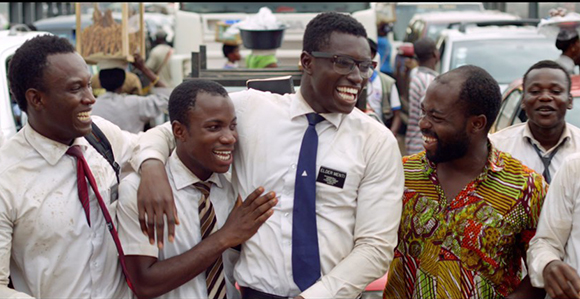Story of Liberian Missionaries Depicted in the Movie Freetown
Contributed By Abby Jennings, Church News staff writer

A scene from the movie Freetown, in which actors played missionaries traveling from Liberia to Sierra Leone.
Article Highlights
- The missionaries escape from a town where a rebel army has taken over by asking a man in their ward to drive them over 200 miles to Freetown.
- They experienced miracles along the route and made it safely there.
- The movie Freetown is about their experiences.
“You had eight Liberian missionaries who are all from eight very different ethnic groups who rode in that little Toyota Corolla. … You see, the gospel brought us together and that’s the big picture. … The gospel of Jesus Christ is the common denominator.” —Brother Marcus Menti, one of the missionaries featured in the movie Freetown
It’s 1990 and Liberia is in the midst of civil war. A rebel army has taken over the town of Monrovia, where a group of missionaries is teaching. Although it’s dangerous, the elders want to continue their missions, but to do this they need to travel across the country to a safer place: Freetown, Sierra Leone.
This true story takes place around 25 years ago, but it has recently resurfaced thanks to the movie Freetown, which is based on the missionaries’ experiences.
In the story, the missionaries started their journey to safety by asking a man from their ward to drive them. He accepted, they piled into his Toyota Corolla in front of the mission home, and they embarked on the over 200-mile journey. They were met with many challenges but also opportunities to spread the gospel and to strengthen their testimonies.
Before John Gaye, Elder Gaye at the time, and his companion met the other missionaries at the car, they had to travel for the entire day to get to the starting point. “We were being led by the Lord. We safely arrived to where they were. They were just about to get into the car to Freetown and we joined them and came together,” Brother Gaye said. That tender mercy gave him “a testimony of how prayers get answered.”
The unpaved roads were not the only reason their trip was difficult. Every so often, they would be greeted by a rebel checkpoint. The rebels would prevent vehicles from passing through the street until they searched for members of the Krahn Tribe, their opponents in the civil war. Brother Gaye is Krahn.
“I know there’s no way that I could’ve been saved had it not been for the hand of the Lord, helping me and leading me through safely because people of my ethnic group—they were being killed just like that,” Brother Gaye said.
At each of the nearly 50 checkpoints, they were on edge. Marcus Menti, one of the missionaries, was grateful for their missionary attire. “There was no day, no hour, that went by, no minute that went by, that we did not wear our missionary attire,” he said. “We had the opportunity not only to initiate in conversation but we were just so different, we would be a quarter-mile away and people would just spot us. … It was a wonderful experience for us being in that missionary attire.”
Because the rebel army was so powerful, some members of the Church had to join them for safety reasons or to get access to food and water. At checkpoints this was helpful for the missionaries because either someone was a member and told the others, or they had heard of missionaries and let them pass as well. The missionaries were grateful for these blessings, but it didn’t make the checkpoints any less intimidating.
“At certain times we would be out of the car and Elder Gaye, because of his ethnicity, was being particularly targeted, just his presence alone with us, it was almost like a near-death experience,” Brother Menti said.
The name “Freetown” couldn’t describe the city any better. They arrived to the peaceful place after almost 30 hours in the car. They were relieved to be free of checkpoints and war.
“Our Heavenly Father tests us. He is with us just like He was with us in our experience in Freetown,” Brother Menti said. “You had people who were fighting civil war based on tribalism, based on your name, based on how you look, based on which region you came from, and yet you had eight Liberian missionaries who are all from eight very different ethnic groups who rode in that little Toyota Corolla, who never one day, one moment, even looked at each other. You see, the gospel brought us together and that’s the big picture. … The gospel of Jesus Christ is the common denominator.”
This story, depicted in the film Freetown directed by Garrett Batty (director of The Saratov Approach), was presented on opening night at the LDS Film Festival in March, made its way to theaters in April, and will be released on DVD in early August.
For logistical reasons the movie features six missionaries instead of the original eight, but the director feels they captured those two missionaries’ stories in other ways.
He was first introduced to the story when he found an article on the Church’s website. “I was very intrigued about this story when I read a little bit about it,” Brother Batty said. He wanted more information and decided to look in the Church archives. Within the archives, he found the missionaries’ letters and transcribed audio accounts. “At that point I thought, ‘Yes, we got a movie here. This is a story that needs to be told,’” he said.
Brother Batty shared that the deeper meaning behind the story of Freetown is enduring challenges. “We don’t make it through life without challenges, and regardless of who we are or where we are, it is our faith in Christ that is going to help us get through these challenges,” he said.
